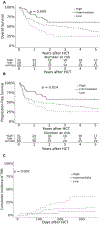Outcomes of Human Leukocyte Antigen-Matched Related Donor and Haploidentical Allogeneic Hematopoietic Cell Transplantation Recipients by Immune Profiles of Recipients and Donors
- PMID: 38801976
- PMCID: PMC11296899
- DOI: 10.1016/j.jtct.2024.05.018
Outcomes of Human Leukocyte Antigen-Matched Related Donor and Haploidentical Allogeneic Hematopoietic Cell Transplantation Recipients by Immune Profiles of Recipients and Donors
Abstract
Haploidentical (Haplo) allogeneic HCTs (alloHCT) have been used more frequently over the last decade as survival is similar to HLA-matched related donor (MRD) alloHCTs. We aimed to identify donor and recipient immune signatures before alloHCT that are associated with clinically meaningful outcomes in MRD vs Haplo alloHCT recipients. This retrospective cohort study of 165 MRD (n = 132) and Haplo (n = 33) alloHCT recipients and their related donors between 2007-2019 with paired peripheral blood samples immunophenotyped for T-cell, B-cell, NK cell and dendritic cell (DC) subsets. Immune cells were quantified before alloHCT in donors and recipients; calculations of immune cell ratios were classified as high, intermediate, and low and analyzed with alloHCT outcomes. Haplo donors were younger than MRD donors (median: 35 vs 51 years), whereas Haplo recipients were older than MRD recipients (median: 68 vs 54 years), were more likely to have a Karnofsky Performance Score ≤ 70 (76% vs 57%), 3+ comorbidities (54% vs 47%), and were in complete remission prior to alloHCT (58% vs 42%). In MRD alloHCT, a lower ratio of CD4+ to CD8+ effector memory cells in the donor was associated with lower 4-yr overall survival (OS; 25% vs 61%; P = .009), lower 4-yr progression free survival (PFS; 25% vs 58%; P = .014) and higher incidence of 1-yr transplant-related mortality (TRM; 39% vs 7%; P = .009) in recipients. A higher ratio of CD8+ effector memory to total NK cells measured in MRD recipients was associated with a higher incidence of grade II-IV aGvHD (63% vs 37%; P = .004) but was not statistically significant for III-IV aGvHD (23% vs 12%). In Haplo alloHCT, a lower ratio of total T-regulatory to CD4+ central memory cells in the donor was associated with lower 4-yr PFS (22% vs 60%; P = .0091). A higher ratio of CD4+ effector memory to CD8+ effector memory cells measured in Haplo recipients pre-alloHCT was associated with lower 4-yr OS (25% vs 88%; P = .0039). In both MRD and Haplo recipients, a higher ratio of CD4+ naïve to CD4+ central memory cells was associated with a higher incidence of grade II-IV aGvHD (64% vs 38%; P = .04). Evaluation of pre-alloHCT immune signatures of the donor and recipient may influence clinically meaningful patient outcomes in both MRD and Haplo transplants.
Keywords: Allogeneic transplant; Flow cytometry; Haploidentical transplant; Immune profiles; Matched related donor.
Copyright © 2024 The American Society for Transplantation and Cellular Therapy. Published by Elsevier Inc. All rights reserved.
Figures





References
-
- Gagelmann N, Bacigalupo A, Rambaldi A, et al. Haploidentical Stem Cell Transplantation With Posttransplant Cyclophosphamide Therapy vs Other Donor Transplantations in Adults With Hematologic Cancers: A Systematic Review and Meta-analysis. JAMA Oncology. 2019;5(12):1739–1748. 10.1001/jamaoncol.2019.3541. - DOI - PMC - PubMed
-
- Brunstein CG, Fuchs EJ, Carter SL, et al. Alternative donor transplantation after reduced intensity conditioning: results of parallel phase 2 trials using partially HLA-mismatched related bone marrow or unrelated double umbilical cord blood grafts. Blood. 2011;118(2):282–288. 10.1182/blood-2011-03-344853. - DOI - PMC - PubMed
Publication types
MeSH terms
Substances
Grants and funding
LinkOut - more resources
Full Text Sources
Medical
Research Materials

